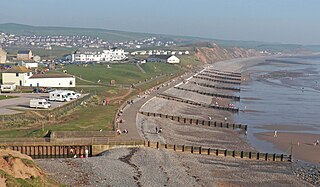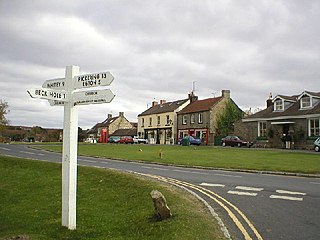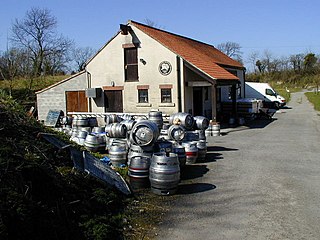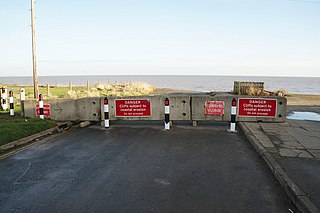
Fylingdales is a civil parish in North Yorkshire, England situated south of Whitby, within the North York Moors National Park. It contains the villages of Robin Hood's Bay and Fylingthorpe and Fyling Hall School.

The Coast to Coast Walk is a long-distance footpath between the west and east coasts of Northern England, nominally 190-mile (306 km) long. Devised by Alfred Wainwright, it passes through three contrasting national parks: the Lake District National Park, the Yorkshire Dales National Park, and the North York Moors National Park. The current actual measured distance is reported as 182-mile (293 km).

Robin Hood's Bay is a village in North Yorkshire, England. It is 6 miles (10 km) south of Whitby and 15 miles (24 km) north of Scarborough on the Yorkshire Coast.

Goathland is a village and civil parish in the Scarborough district of North Yorkshire, England. Historically part of the North Riding of Yorkshire, it is in the North York Moors national park due north of Pickering, off the A169 to Whitby. It has a station on the steam-operated North Yorkshire Moors Railway line.

Cropton is a village and civil parish in the Ryedale district of North Yorkshire, England. It is on the border of the North York Moors National Park, 3 miles (5 km) north-west of Pickering.

Robin Hood's Bay railway station was a railway station on the Scarborough & Whitby Railway situated 15 miles (24 km) from Scarborough and 6 miles (9.7 km) from Whitby It opened on 16 July 1885, and served the fishing village of Robin Hood's Bay, and to a lesser extent the village of Fylingthorpe. On the north-bound journey trains had to climb a mile and a half at 1-in-43 out of the station.

The Robin Hood's Bay Marine Laboratory was a marine scientific research and education unit in North Yorkshire, England, from 1912 to 1982. Purchased in 1998 by the National Trust, the previous structure was demolished, and the present building constructed to the style of the old coastguard station and opened as a visitor and interpretation centre.

The A169 is an A road in North Yorkshire, England. It runs from the A64 at Malton on the edge of the Yorkshire Wolds through the Vale of Pickering and across the North York Moors to join the A171 just west of Whitby. It is a single carriageway for all of its 25-mile (40 km) route. Whilst it is not considered a Primary Route nationally, the Ryedale Local Transport Plan lists it as part of its Major Road Network alongside the A64, A166 and A171.

Fylingthorpe is a village in the Fylingdales civil parish of North Yorkshire, England.

Whitby Lifeboat Station is a Royal National Lifeboat Institution (RNLI) lifeboat station located in Whitby, North Yorkshire, England. It is one of nine situated along the Yorkshire coast.

The Yorkshire coast fishery has long been part of the Yorkshire economy for centuries. The 114-mile (183 km) Yorkshire Coast, from the River Tees to the Humber estuary, has many ports both small and large where the fishing trade thrives. The historic ports at Hull and Whitby are important locations for the landing and processing of fish and shellfish. Scarborough and Bridlington are also sites of commercial fishing.

The Fylingdales Group of Artists is a group of Yorkshire-based artists in England.

The Lion Inn is a public house at Blakey Ridge, near Kirkbymoorside, in North Yorkshire, England. The building was completed between 1553 and 1558, and has been used as an inn for four centuries, sitting adjacent to a road across the moors between Castleton and Hutton-le-Hole. During the ironstone industry boom in Rosedale, it catered mainly for those engaged in the mining industry. The inn is known for being subjected to extremes of weather, like Tan Hill Inn, also in North Yorkshire.

Lilla Cross is a marker on Lilla's Howe, Fylingdales Moor, in North Yorkshire, England. A story relates how King Edwin of Northumbria placed the cross there to mark the grave of Lilla, one of his thegns who saved his life during an assassination attempt. Whilst the current cross is believed to date to the 10th century, the original was placed there in 626. Even so, Lilla Cross is known for being the oldest marker of its type on the North York Moors. The ancient cross marks the intersection of pathways across the moor, the edges of four parishes and is also a waymarker on the Lyke Wake Walk.

Coastal erosion in Yorkshire has been a process that has been documented since Roman times. Rates of erosion on the Holderness coast are known to be the worst within Europe, with the East Riding coastlines having the greatest number of at risk properties in England. Almost 30 settlements on the Holderness coastline have been lost to the sea, with more being subjected to flooding and loss exacerbated by a projected rise in the sea level caused by climate change. Due to the limited protection from effects of rising seas in the Humber Estuary, the region has the greatest value of assets at risk from flooding than anywhere else in England.

Raw is a hamlet in the Borough of Scarborough of North Yorkshire, England, near to the villages of Fylingthorpe, Robin Hood's Bay, and Hawsker. The hamlet is mostly agricultural in nature and it lies 0.5-mile (0.8 km) north-west of Fylingthorpe, 4.5 miles (7.2 km) south-east of Whitby, and due east of the A171 road.

Ramsdale Beck is a small river that feeds directly into the North Sea between Robin Hood's Bay and Ravenscar on the North Yorkshire coast in England. The stream, which rises on Fylingdales Moor, has two waterfalls, and historically was used to power two corn mills. The beck flows through a small ravine known as Ramsdale Valley. There is another Ramsdale Beck in Scarborough which connects Scarborough Mere and Falsgrave to the sea.

Robin Hood's Bay Lifeboat Station was a Royal National Lifeboat Institution (RNLI) lifeboat station, situated at Robin Hood's Bay, on the coast of North Yorkshire, England. The lifeboat station had been operating for just over 100 years intermittently when it was closed by the RNLI in 1931. The withdrawal of the lifeboat capability from Robin Hood's Bay was due to the Whitby lifeboat being able to be launched from Whitby, and into the bay at Robin Hood's Bay, before the bay lifeboat itself could be manhandled into the sea.

Beggar's Bridge is a packhorse bridge straddling the River Esk in Glaisdale, North Yorkshire, England. The bridge dates back to 1619 and was reputedly built by a former poor farm worker who wanted to meet his love but could not due to the river being in flood. Having become rich working at sea, then becoming the mayor of Kingston upon Hull, Ferris built the bridge at that point when flooding prevented him crossing it years before. The structure is both a scheduled monument and a grade II* listed building.

The Laurel Inn is a historic pub in Robin Hood's Bay, a village in North Yorkshire, in England.





















